Keep dahlias free of earwigs, slugs and snails without chemicals
You can keep slugs, snails and earwigs away from your dahlias without chemicals.
I’ve been talking to head gardener and garden consultant, Steve Edney, whose family have grown dahlias for generations. And he only gardens organically, so his advice is chemical-free. See here for Steve’s advice on choosing and growing dahlias.
Firstly, he says that pest control is now about balance not eradication. As gardeners, we know that we can’t get rid of pests permanently. We can only minimise the damage they do.
This applies both to gardening without chemicals and gardening with. Even if you use the fiercest spray you can buy, the slugs, snails and earwigs will ultimately be back.
So ‘it’s about balance,’ he says. You will get a few nibbled leaves and petals, but you can achieve a beautiful overall effect without every flower having to be perfect.
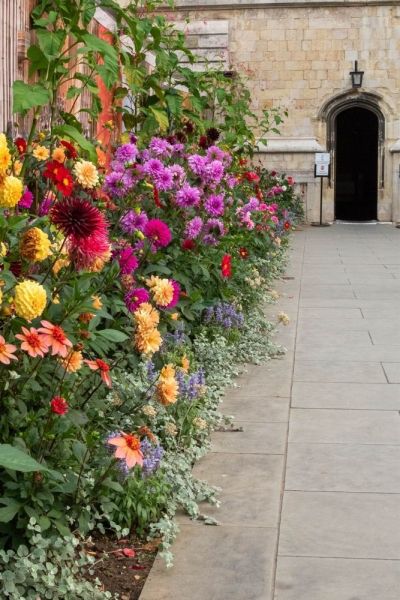
Steve Edney created this dahlia border leading up to a main entrance door of Canterbury Cathedral. It is gardened organically, without chemicals.
Steve has just created a dahlia border for Canterbury Cathedral, using chemical-free gardening. So this approach is not just for wildlife gardeners but also for those whose gardens have to withstand the scrutiny of thousands of visitors. You can see more views of the border and of Canterbury Cathedral in this video.
Steve and his partner Louise also grow plants in their own nursery, The No Name Nursery in Kent. They sell the plants at plant fairs around South East England. And plants for sale also have to look good!
Snail and slug deterrents without chemicals
Slugs and snails are the number one pest on dahlias.
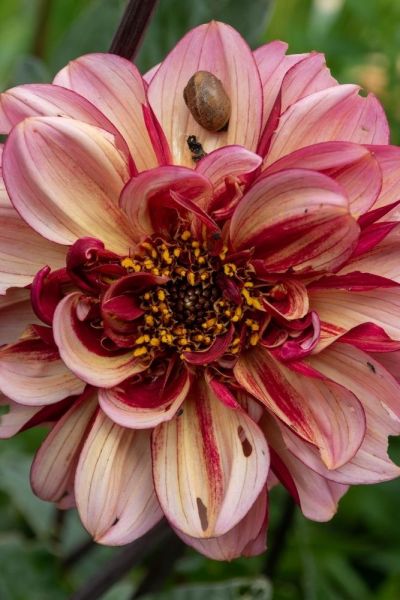
Snails have nibbled this Dahlia ‘Seniors Hope’ in my garden. I also garden without chemicals, but I really had to hunt for a dahlia badly affected by snails and slugs. I counted 60+ dahlia flowers blooming in my border today, and only around three had this kind of damage.
Steve uses two methods of natural pest control. Firstly, he advises using sheep’s wool or sheep’s wool pellets around the base of your dahlias to deter slugs and snails.
The key to using sheep’s wool pellets correctly is to use them thickly so that they create an almost impenetrable mat. I tried sheep’s wool pellets once. I scattered them thinly, as if they were conventional slug pellets. That didn’t work. You have to be generous with your wool or wool pellets.
The wool will slowly compost down naturally into the soil without causing it any harm. It will even help improve its ability to retain water.
If you live in sheep country, Steve suggests using the wool that gets caught in branches and fencing. Or presumably, you could buy some raw wool directly from a farmer or a farm shop.
It’s important to start controlling slugs and snails in your garden early in the season.
I interviewed the RHS’s Principal Horticultural Advisor, Leigh Hunt, on gardening for biodiversity. He said that the RHS no longer classifies snails and slugs as ‘pests’ because they have a role to play in a garden. They clear up dead and dying foliage and help compost heaps break down. Slugs and snails are also food for songbirds. However, not all gardeners will be convinced!
Organically approved slug pellets
Steve also uses organically approved slug pellets, with ferric phosphate. Their key ingredient is iron. The slugs and snails eat it, and they then don’t want to feed any more. If birds or hedgehogs eat them, they won’t be harmed.
I also use slug pellets with ferric phosphate. You can minimise their use by only using them to protect small and young plants. Once plants are a reasonable size, they seem to withstand snail and slug damage.
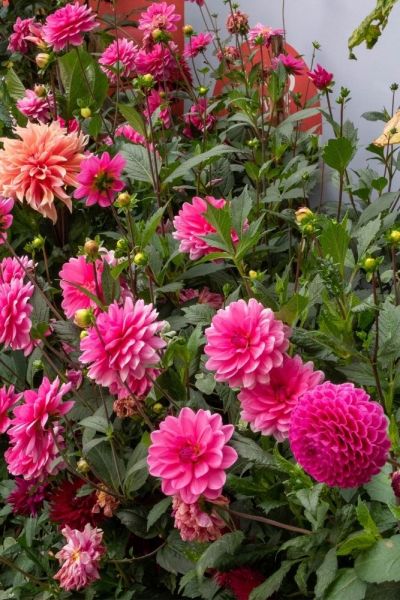
This group of dahlias in Steve’s Canterbury Cathedral border show what can be achieved if you achieve a good balance of pests and predators in a garden. Dahlias are ‘Labyrinth’, ‘GH Lammerse’ and ‘Belfloor’
Unlike with sheep’s wool, you need to scatter these thinly. And Steve says that they need to be damp in order to work properly. So if the soil is dry, water it, either before or after you scatter the slug pellets.
There will always be some nibbled leaves when you garden without chemicals, but you don’t notice them in a full border. And there is also some damage to petals, but I have noticed that this is mainly to the older, outer petals.
(Note that links to Amazon are affiliate, so I may get a fee if you buy but it won’t affect the price you pay. And I’ve only linked to the products I buy myself.)
Grow young plants on in pots until they’re big enough to be planted out
This advice comes from another expert plant grower, Stephen Ryan of the Horti-Culturalists YouTube channel. He grows vulnerable plants on in pots until they’re big enough to survive some slug and snail damage when planted in the earth. He also keeps these pots up on shelves outside because slugs and snails can climb but don’t often bother.
Stephen also mixes slug resistant plants in with vulnerable ones, because this can slow slugs and snails down. See here for Stephen’s recommendations on snail and slug resistant plants.
Dead head dahlias early and often
Steve suggests dead heading dahlias when the outer petals start to go over, rather than waiting for the whole flower to die and start turning to seed. While this advice isn’t wholly about pest control without chemicals, it does actually help.
In vegetable gardening, slugs and snails are the garden’s rubbish disposal experts. They ‘tidy away’ the older, decaying leaves. One way of minimising slugs in a veg patch is to keep trimming away older, outer leaves. Dead heading flowers when the outer edges start to go over is the flower gardening equivalent.
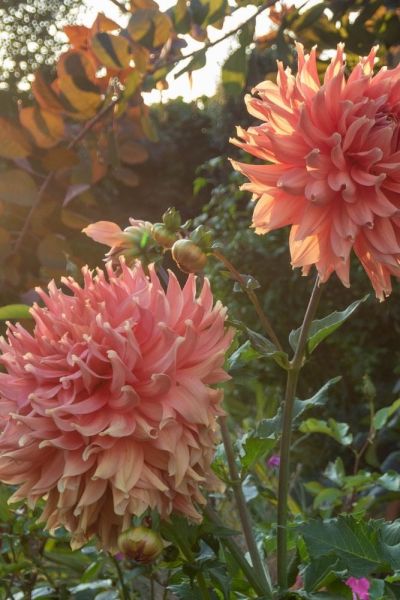
The outer edges of the petals in this dinnerplate dahlia ‘Babylon Bronze’ in my garden show that the flower is beginning to ‘go over’. I ought to dead head it now, but it’s still such a big presence in the border.
But I find this so difficult when there is still a huge, colourful bloom in the border! But when I look at the nibbled petals in my garden, I can see that it’s definitely mainly in the older flowers that are going over. Earlier dead heading would minimise this.
How to deal with earwigs without using chemicals
Steve says that when you see nibbled petals, it may not be snails that are to blame. It may be earwigs. They’re the number two pest on dahlias.
‘The old way of dealing with earwigs without chemicals used to be to put an upturned pot filled with some straw on the top of a pole,’ says Steve. The earwigs went up into the straw for shelter and you could tip them out somewhere else.
However, Steve has other ways of minimising earwig damage in dahlias.
Firstly, he says that some dahlias are more likely to attract earwigs than others. The big decorative dahlias with their layers of petals offer good hiding places for earwigs. So they are more likely to suffer.
But the simpler single and collerette dahlias don’t offer so much cover. So if you really don’t want earwigs, don’t grow the big decorative dahlias.
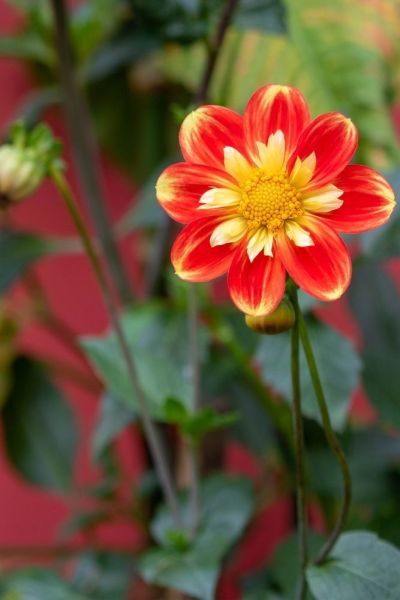
This beautiful open-faced dahlia ‘Pooh Swan Island’ at Canterbury Cathedral offers fewer hiding spaces for earwigs than the bigger, fuller petaled ‘decorative dahlias.’
However, that seems a bit sad. Steve suggests that if you do want to grow them, smear some Vaseline around the main stems. The earwigs won’t be able to get past it.
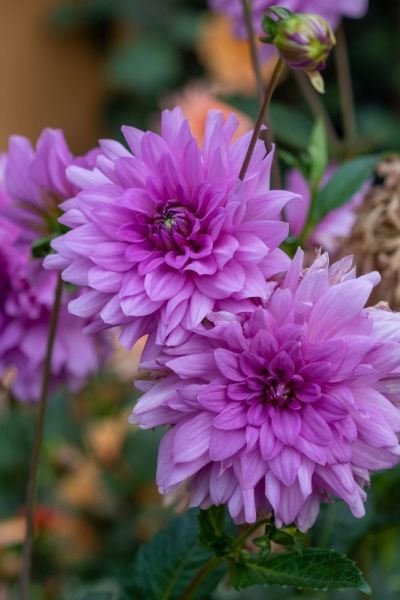
The bigger decorative dahlias hide earwigs better. But if you only grow a few of them, you can smear Vaseline on the major stems so the earwigs can’t get past. This is ‘Blue Boy.’
Steve also says that earwigs may be a pest on dahlias, but they are otherwise an asset in the garden. They feed heavily on aphids, blackfly and greenfly.
So it’s all about balance!
I interviewed Neil Miller, head gardener at Hever Castle Gardens, on how to grow roses. He told me that he never sprays his roses to deter aphids, because he too runs a wildlife-friendly professional garden. In June, the roses are covered with aphids. But he leaves them. And two or three weeks later the aphids are gone ‘and the thrushes are waddling around with big bellies,’ he says.
For two years running, I’ve tried this on my dahlias. On 6th July, the stalks of several dahlias were thick with aphids. I did nothing to control them. By the beginning of August, they were all gone. They were eaten by the birds and (perhaps) some earwigs.
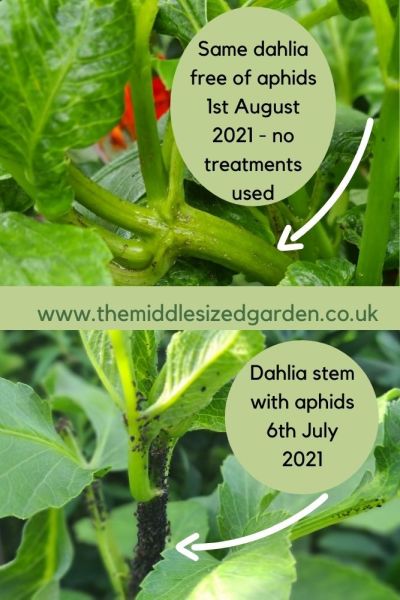
My Dahlia ‘Cafe au Lait’ was thick with aphids on 6th July 2021. I left nature to sort it out and by the 1st August, there were no aphids left.
If you have been using pest killers for a while, it may take time for your predator population to build up. So if you try leaving your aphids, and the birds don’t sort them out, check how wildlife friendly your garden is.
As Steve says, you need to invite wildlife into your garden if you want them to control your pests without chemicals. That means offering water as well as plants that offer food or shelter. And check that any products you use to kill off pests are organically approved. And minimise their use in the garden. There’s more about creating a wildlife-friendly garden here.
And if you’re wondering whether to dig up your dahlias at the end of summer, this post may help.
What if my dahlia isn’t flowering?
Steve says that if your dahlia isn’t flowering, the most likely reason is that it hasn’t had enough water. ‘The singles and the collerettes, with smaller flowers, are more drought-resistant’, he says. But the larger, ‘dinnerplate’ dahlias need much more water than most in order to flower properly.
If your dahlia has buds, but they just wither away without turning into flowers, he says that is most likely due to lack of water.
Although you don’t always have to fertilise dahlias, the bigger flowers do need more nutrition than the smaller or single-flowered ones. Steve uses Maxicrop Seaweed feed on his dahlias.
And, of course, if you’re growing dahlias in pots, you will either need a long term slow release feed or to feed the dahlias weekly in the flowering season.
The products I use to control pests without chemicals
I’ve tried a number of brands of sheep’s wool pellets and organically approved slug pellets. The ones I’ve continued to buy and use are Vitax Slug Gone Natural Wool Pellets , Richard Jackson’s Slug and Snail control and Neudorff Slug and Snail killer. Both of the last two contain ferric phosphate as their active ingredient.
Some people say that even ferric phosphate, which is a naturally occurring element and approved for organic use, can cause damage to earthworms or to the soil generally. I have searched for scientific studies on this, but have so far failed to come across any. I will keep looking. It also makes sense to minimise your use of any product.
It’s also worth remembering that very toxic slug pellets, made of metaldehyde, have been banned in the UK since March 2021. But these slug pellets are still widely available elsewhere, such as in the Republic of Ireland, so read your labels very carefully.
And I keep a pair of Darlac Snips beside the back door, so that I can dead head flowers regularly when I go out into the garden.
Pin to remember dahlia pest control without chemicals
And click here for a free weekly email from the Middlesized Garden with tips, ideas and inspiration for your garden.

























Hi, this year I grew my dill amongst my dahlias. They seem to be free of earwigs. An effective deterrent? Maybe.
Interesting thought, thank you.
There is way too much cruelty in the wool industry for wool to be used EVER in my cruelty free life. Also sheep have to be bred for wool so not eco friendly.
As for the pellets you have also advised to buy and feed to wildlife. These dissolve the digestive system of snails and slugs and possibly other insects and that is why they stop eating! It is a slow death. Stop killing for gratification! Flowers are not more important than lives. Put some coarse gravel down and the snails and slugs will not cross it. Or some core matting
Thank you for sharing your thoughts.
Wool is an all round natural underused excellent product with many uses also excellent for the environment
Indeed!
How much matting do you put? The whole soil area or just a loop around the bottom of the dahlia stem??
I’m not quite sure what this question means – we haven’t recommended matting in this post. I wonder if you mean the sheep’s wool pellets? These aren’t matting,they’re pellets which you scatter around the plant to create a barrier to the slugs and snails. You need to scattter them quite thickly and there are mixed results. I think most people would recommend against using actual matting as slugs and snails enjoy hiding under it – if you ever pick up a piece of horticultural fleece and look underneath, you’ll find quite a colony of slugs and snails.
Really liked the wool pellet tip to keep the slugs and snails away.
Thank you. I’m sorry that I’ve had to remove the link, as the links attached to comments are being misused by many.
Good stuff from Steven Edney, as always. The swathe of wool pellets has to be wide as well as thick, I find, but they are really effective, and also act as a fertiliser as they gradually rot down,
I haven’t tried them yet – or rather I did once but scattered them lightly like standard slug pellets. But I will try again, and go wide as well as thick, thank you.
Intresting tips
thank you!